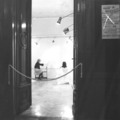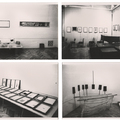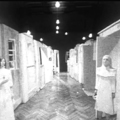Parallel Chronologies. The Invisible History of Exhibitions
documentary and research exhibition
 Pages from the chronology published in the exhibition catalogue, Künstler aus Ungarn, 1980, Wilhelmshaven, (1974), compiled by: Dóra Mauer Pages from the chronology published in the exhibition catalogue, Künstler aus Ungarn, 1980, Wilhelmshaven, (1974), compiled by: Dóra Mauer |
tranzit. hu organizes an exhibition and international symposium with the title Invisible History of Exhibitions, which aims at the formation of a shared knowledge and discourse on Eastern European art exhibitions from the 1960s till now.
Parallel Chronologies investigates the exhibition as a cultural phenomenon and a genre on its own right focusing on the period determined by the state socialisms of the Eastern European region. The project intends to break with the usual ways both international and local art events and publications either ignore or exoticize this field. For this aim we present a network of professional relationships, exhibitions, events, and art spaces instead of the sheer display of artworks from the period.
The exhibition contains two archives dealing with neo-avant-garde art from Belgrade and Novi Sad. The prelom kolektiv has studied several significant events of the SKC, the Student Cultural Center in Belgrade in the 70s, and kuda.org new media center has collected the most important documents of the neo-avant-garde in Novi Sad. The third section of the exhibition presents progressive art events from the 60s-70s in Hungary. The exhibition and event documentations from Hungary are structured around a research asking various Hungarian art professionals about the art events from this period they find the most significant in relation to their own practice.
Instead of aiming at an objective history gained from the synthesis or reconciliation of differing individual points of views we rather would like to trace the idiosyncratic pattern of difference and accordance, the map of blind-spots and legends. The exhibition also addresses chronologies as important channels of mediating art events of an epoch. Chronologies play a defining role in transforming atomic events into histories and canons especially in the case of Eastern-European art events that happened in the second publicity during the 60s and 70s.
The exhibition was realised in the framework of the project Aways Has Its Consequences.

 tranzit is a contemporary art program supported by the Erste Bank Group
tranzit is a contemporary art program supported by the Erste Bank Group

 The exhibition Parallel Chronologies and the symposium The Invisible
History of Exhibitions is part of the international project Art Always Has
Its Consequences co-financed by the Culture 2007 program of the European
Union (partners: WHW Zagreb, tranzit. hu, Muzeum Sztuki Łódź, kuda.org
Novi Sad).
The exhibition Parallel Chronologies and the symposium The Invisible
History of Exhibitions is part of the international project Art Always Has
Its Consequences co-financed by the Culture 2007 program of the European
Union (partners: WHW Zagreb, tranzit. hu, Muzeum Sztuki Łódź, kuda.org
Novi Sad).








Utolsó kommentek